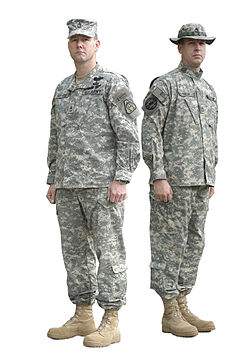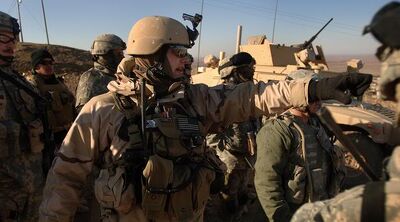
Two soldiers wearing the Universal Camouflage Patterned ACU as well as UCP-patterned patrol cap (left) and boonie hat (right).
The Army Combat Uniform (ACU) is the current combat uniform worn by the US Army. It is the successor to the Battle Dress Uniform (BDU) and Desert Camouflage Uniform (DCU) worn from the 1980s through the early 2000s. It features a number of design changes, as well as different camouflage pattern from its predecessor. The ACU and its component materials are manufactured by the existing industrial infrastructure which produced the now-obsolete BDU. Official military-grade ACU's are made of 50% nylon and 50% cotton. All other blends are not official issue.
Patterns[]
Universal Camouflage Pattern[]
- Main article: Universal Camouflage Pattern
The US Army uses the Universal Camouflage Pattern (UCP), which blends tan, grey, and green to work equally in desert, woodland, and urban environment. Similar to the USMC's MARPAT and Canadian CADPAT camouflage schemes that preceded it, the pattern design is based on research into Dual Texture (Dual-Tex) Camouflage conducted in the 1970s. This design, however, is not as effective as patterns with color schemes specific to a single enviroment and may have been implemented due to budgetary constraints.

US Army soldiers in May 2011, wearing the ACU in the Universal Camouflage Pattern, along with its replacement MultiCam pattern (second from left) in Paktika Province, Afghanistan.
The color scheme of the Army Combat Uniform is composed of a slate grey, desert sand, and foliage green pixel pattern, which becomes darker or lighter depending on exposure to sunlight. The shade black was omitted from the uniform since it is highly visible both to the naked eye and to modern optics. However, it does utilize several shades of grey ranging from very light to extremely dark. Pure black, when viewed through night vision devices, appears excessively dark and creates and un-desireable high-contrast image.
MultiCam / OEF camouflage pattern[]
- Main article: MultiCam
Soldiers deployed to Afghanistan are issued a version of the "MultiCam" pattern. Since late 2010, all US Army soldiers deployeing in support of Operation Enduring Freedom are issued flame-resistant ACUs in the Operation Enduring Freedom Camouflage Pattern (OCP). These uniforms are designed to prevent third-degree burns, along with up to thirty percent of second degree burns. Additionally, the uniforms are treated with a chemical permethrin to help protect soldiers from insect-borne diseases like malaria. Some US Army soldiers during the latter stages of the Iraq War also wore the ACU in OCP; some were seen wearing them as late as Dec. 2011, when the United States withdrew its military forces from the country at the end of the war.
Components[]

US Army soldiers patrol the streets of Baghdad, Iraq while wearing the Army Combat Uniform.
The Army Combat Uniform features hook-and-loop fasteners, also known by the genericized trademark velcro, on its sleeve pockets.
The cost to each soldier is $120 per uniform, compared to $58 for a BDU, but clothing allowances in soldiers' pay have been adjusted to compensate for the increased cost. Insignia and tags, such as name and branch tapes, are extra purchases. Uniforms purchased from commercial websites and surplus stores that sell to the general public to not include the IR squares, which are restricted to military personnel because of their sensitive nature.
Jacket[]

A US Army soldier in Kunar province during Operation saray in April 2006.
The ACU jacket uses hook-and-loop-backed attachments to secure items such as name tapes, rank insignia, and shoulder patches and tabs, as well as recognition devices such as the US flag patch and the infared tab.
Near Infared Signature Management Technology is incorporated to minimize the infared silhouette. Permanent IR IFF squares are sewn to each shoulder to help identify friendly personnel when night vision devices are used, and are protected by Velcro tabs in garrison or when not in use.
Three US flag insignia are authorized for wear with the ACU: full-color, full-color IR, and subdued IR. The subdued version is only worn as directed under tactical or field conditions. On the right shoulder of the ACU, the US flag is depicted with the union (stars) to the viewer's right, instead of the usual left (flag's own right); this is to give an impression of the flag moving forward with the wearer. Subdued shoulder sleeve insignia are always worn.
The jacket's Mandarin collar is worn up in combat to fit with the Improved Outer Tactical Vest body armor, and worn in the down position otherwise. The front closure is zippered and reinforced with velcro, designed for use with OTV. The tilted chest pockets, cuffs, and elbow pad insert pockets also utilize hook-and-loop closure. There is a three slot pen pocket on the left arm of the jacket, and the blouse bellows for increased mobility.

A US Army soldier from the 151st Infantry Regiment in Parun, Afghanistan.
Originally only pin-on skill badges were authorized for wear on the ACU, with no more than 5 at any time. In the summer of 2011, regulations were changed to allow for wearing of sew-on embroidered skill badges like the ones work on the older BDUs. The 5-badge limit remained in effect, and there could be no mixing of sew-on and pin-on badges. At the same time, the US Army nametape, personal nametapes, and rank insignia could be sewn-on at the wearer's preference. Skills tabs, such as the President's Hundred Tab, Special Forces, Ranger, and Sapper are worn on the left sleeve pocket and are subject to a 3-tab-only rule. A tab that is an integral part of a unit patch, such as the "Mountain" or "Airborne" tab, is not counted against the rule.
Current regulations require the jacket to not extend below the top of the cargo pocket and not be higher that the bottom of the side pocket. Sleeves are to be worn down at all times, in contrast with the earlier Army BDU policy which authorized sleeve-folding for the summer uniform.
In the field, the jacket may be replaced by the flame resistant Army Combat Shirt when worn directly under the IOTV.
Trouser[]
The ACU trouser (or ACU pant) is worn with a two-inch nylon web belt, and features Velcro pouches for knee pad inserts, two forward tilted thigh storage pockets with elastic drawstrings and Velcro for closure during movement, and two calf storage pockets, one on each pant leg with Velcro closure. In addition, the pants legs can be bloused and must not extend past the third eyelet of the boots as per AR 670-1. Army combat trousers with flame resistant materials are being issued for use in Iraq and Afghanistan.
Headgear[]

A US Army soldier in March 2007, wears a helmet with a UCP camouflage cover during the Iraq War.
Typically, the ACU is worn with the Advanced Combat Helmet, a patrol cap, or a boonie hat as appropriate. The patrol cap is a kepi-style straight-sided, flat-topped soft cap, with a double thich bill and internal pocket. When in garrison, the maroon, tan, and green berets may be worn by paratroopers, Army Rangers, and Army Special Forces respectively. The green micro fleece cap is authorized for field and garrison use outside of unit PT, per local command. The fleece cap may be foldied with a 1-2" fold through it may not ever be rolled. The name tape is worn on the back of the patrol cap. Sew-on rank is recommended but pin on rank is authorized on the ACU patrol cap and the ACU boonie hat.
T-shirt[]
The ACU is worn with a moisture-wicking sand colored t-shirt. A foliage-green t-shirt, which is 100% cotton, has been authorized for wear by soldiers and for some training environments or deployed soldiers; authorized environments include Iraq, Afghanistan, and Korea, by amendment of AR 670-1, Nov, 2011. Authorization extends to those outside flight or fuel MOSs during tours in applicable regins. Black t-shirts are authorized for wear by certain instructors on Army posts.
Footwar[]
The ACU is worn with tan Army Combat Boots and moisture wicking socks. Commercial versions of this boot are authorized without limitation, complying with the following regulations - be at least 8 inches in height, be made of tan rough side out cattle hide leather with a plain toe and tan rubber outsoles, and be without zippers, metal cleats, or side tabs. The Mountain Combat Boot is available for difficult terrain, Extreme Cold Vapor Barrier Boots for cold weather, and the Modular Boot System is being developed to replace the ACB.
Uniform care[]

The ACU of a US Navy sailor attached to a US Army unit during the Iraq War.
Although common practice (though not required by regulation) with the BDUs, ACUs are not to be starched. As per the ALARACT message in effect until a new revision of AR 670-1 is released, "Soldiers will not starch the Army Combat Uniform under any circumstances. The use of starch, sizing, and any proccesses that involve dry-cleaning or steam press will adversely affect the treatments and durability of the uniform and is not authorized".
Starching the uniform has been shown to cause discoloration. It enhances the IR signature, making the uniform inappropriately bright under night vision viewing.
Personnel have been instructed that the uniform must be washed with a mild detergent that does not contain "optical brighteners". Detergents with optical brighteners may cause discoloration of the uniform, which would nullify the purpose of the very specific camouflage design and result in possible unwanted

Sgt. Michael Duran (center) points out Al-Qaeda positions to Iraqi forces. He is wearing the three-color uniform pattern. Pvts. Sean Almstead and Brett Kring (behind Sgt. Bueller) wear ACUs. Cpl. Curtis Myers (right) wears the Desert Night Camouflage patterned uniform.
detection of personnel using the uniform in combat. Some detergents have phosphorescent properties which enhance an enemy's ability to see the soldier when viewed with night vision devices.
Soldiers have expressed concerns about the velcro on the ACU. Dirt and mud clog the hooks and loops or they can wear out with use, requiring the use of cleaning brushes for clearing the velcro as part of daily maintenance. Zippers are also a topic of concern. Soldiers express concern because the zippers (as with any zipper) can bind up, and render the uniform uncomfortable to wear, especially with body armor.
As of 2010, Velcro will be phased out in favor of buttons, which are silent, work well in dust, mud, or snow, support heavier use, and hold more securely.
Initial fielding[]
The process of replacing the US Army's M81 Woodland and Three Color Desert Pattern BDU and DCU was to begin in April 2005. However, the fielding process began two months earlier through the Rapid Fielding Initiative. Soldiers from the 48th Infantry Brigade Combat Team were the first US Army unit, active or reserve, to receive the ACU, subseqently deploying the entire brigate to OIF combat in May 2005. Initial reception of the ACU was mixed, with complaints of insufficient durability and excessive maintenance. As of the early 2010s, the use of multiple camouflage patterns within a US Army unit is now seldom seen, as the ACU in UCP is now standard issue.